Features and Benefits of Using Verde-Cal
500 pounds will yield results equivalent to 1 ton of typical gypsum. Leaches excessive amounts of Sodium (Na) and Magnesium (Mg) from the soil. Supplies Calcium (Ca) without raising pH. Helps loosen compacted, heavy clay soils. Excellent source of Sulfate Sulfur. Satisfies the Calcium need of both the plant and the soil. Improves soil aeration.. read more →
Carboxylic Acids… What are they and what’s the difference?
Carboxylic acids are a form of an organic acid. All carboxylic contain one Carbon atom, one Oxygen atom, and one hydroxyl group. The combination of the atoms looks like this (COOH). Any grouping of molecules that contain these (COOH groupings) is considered a carboxylic acid. There are many, many types of carboxylic acids, some common examples are: Citric Acid (beverages), Acetic Acid (vinegar), Humic Acid, Fulvic Acid, Salicylic Acid (acne treatments), Malic Acid (sour tasting food ingredient), Lignin Sulfonate (wood pulp by-product), Oxalic Acid (Oxy Clean and other cleaners), Formic Acid (ant bites), some carboxylic acids are mixed with alcohols to produce flower smells and fragrances for perfume and colognes. read more →
Welcome to the NEW Pacific Northwest…
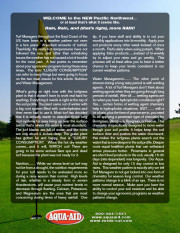
Turf Managers throughout the East Coast of the US have been in a weather pattern not seen in a few years. Abundant amounts of rainfall. Thankfully, the really hot temperatures have not followed the rain, and other than scheduling issues the weather has not caused a lot of trouble for the most part. A few points to remember about your agronomic program during these rainy times. The term “LUXURY CONSUMPTION” can refer to many things but were going to focus on the two main issues for this article. Nutrition and Water Management. read more →
Understanding a Plant Tissue Analysis
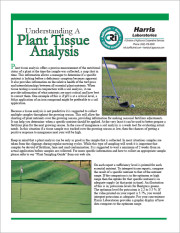
Plant tissue analysis offers a precise measurement of the nutritional status of a plant at the time the sample was collected; a snap shot in time. This information allows a manager to determine if a specific nutrient is lacking before a deficiency symptom becomes apparent. It also provides information on the relative health of the turf grass and interrelationships between all essential plant nutrients. When tissue testing is used in conjunction with a soil analysis, it can provide information of what nutrients are most critical and how best to correct them. One example of this is if pH is at a critical level, a foliar application of an iron compound might be preferable to a soil application. read more →
I received a call from a distributor salesman who had a golf course in South Texas that wanted to try VERDE-CAL G (enhanced gypsum) to combat the extremely high Sodium (Na) levels in his soils. He has very tough growing conditions. His soil base saturations levels were not balanced, and his water sources at times made things even worse (switching between irrigation lakes to wells to effluent). read more →
What is most commonly overlooked when discussion soil fertility is calcium—more specifically, the form and application of calcium to your turf. It’s true that nitrogen, phosphorus and potassium are used in greater percentages than calcium, but no other nutrient is used more by weight and volume than calcium. In the soil, the relationship of calcium to other nutrients (e.g., magnesium, potassium and sodium) is dynamic, so to limit its importance to pH adjustment is short-sighted. Calcium is the second highest element percentage in plant tissue. Literally, then, calcium levels in both soil and plant are the backbone of an effective turf program. read more →
Optimizing Your Overseed Requires the Use of Calcium
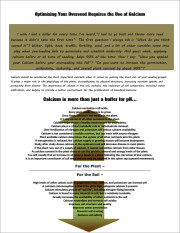
I wish I had a dollar for every time I’ve heard, “I had to go back and throw more seed because it didn’t take the first time.” The first question I always ask is “What do you think caused it?” Water, light, heat, traffic, fertility, seed, and a lot of other variables come into play when overseeding fails to germinate and establish uniformly. And guess what, applying calcium before or at time of seeding, helps 90% of the time. Now I say. “Have you applied your Calcium before your overseeding this fall?” “Do you want to increase the germination, uniformity, maturity, and overall plant survival by about 90%?” read more →
Water Made Easy
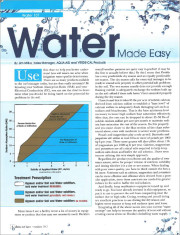
Many times I see a facility invest a lot of money in equipment or product that they may not necessarily need. Florida’s overall weather patterns are quite easy to predict! (I may be the first to actually believe this.) By this I mean that Florida has a very predictable dry season and an equally predictable wet season. The dry season calls for every turf manager to be ready to amend soils properly to offset potential salt problems in the soil. The wet season usually does not provide enough flushing rainfall to adequately exchange the sodium built up on the soil colloid if those soils haven’t been amended properly during the dry season. read more →
Soil Testing Procedures for Calcareous Soils
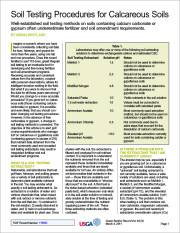
Imagine a scenario where you have been consistently collecting soil data for tees, fairways, and greens for more than five years, using one lab and one procedure. Does this sound familiar to you? If it does, great! Regular soil testing is an invaluable tool for developing and fine-tuning fertilizer and soil amendment programs. Receiving accurate and consistent values from the laboratory, coupled with personal observations, allows for intelligent decision making in the field. But what if you were to discover that the data for all those years was wrong? Would you change to a more accurate procedure? read more →
Sodium and Salinity
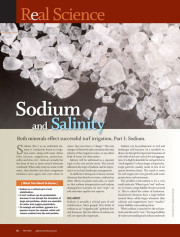
Sodium (Na+) as an individual element is commonly found in irrigation water, along with many others (like calcium, magnesium, potassium, sulfur and iron, etc). Salts are actually the dry form of two or more elements combined. When salts come in contact with water, they dissolve into their component elements once again, but when in water, they now have a “charge.” The sum charges of dissolved salts constitute the total salinity of the irrigation water, or any other body of water, for that matter. read more →


